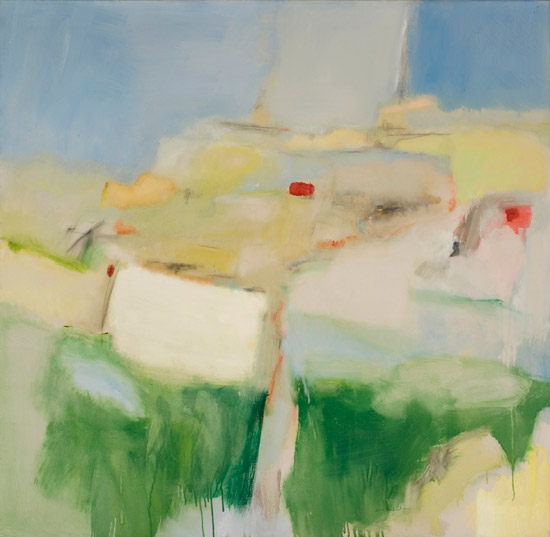The heyday of 1950s and ’60s abstraction is the summer centerpiece of New York’s Tibor de Nagy Gallery schedule. “Starting Out: 9 Abstract Painters 1958-1971” is a calming, peaceful show, a refreshing pause of summer Rosé amidst the Warhol-derived dada firewater that’s presently sloshing about the art world.
Abstraction has been reappearing in galleries these past few years at an increasing rate, but the reasons why are a bit of a mystery. Judged to be an exhausted art form 30 years ago, abstraction staging a resurgence seems to lack intellectual support—but on the other hand there seems to be a dearth of intellectual support for any style of working.
Perhaps that was all that was needed for this culture of painters, occasionally sculptors, and their loyal viewers to make a bit of a comeback. Entering a gallery showing these bygone abstractions is like wandering into a classic car show full of bright chrome (not done anymore), protruding fins (not done anymore), rolled steel dashboards (not done anymore), spoked wheels (not done anymore) and the now-amusing 12 mpg, currently approached only by Range Rover and the most unabashed gas guzzlers. Abstraction could be said to be having a “the way we were” moment.
It’s part sentimentality for a more naïve time, when abstraction sprung from “confessional poetry.” This new mix of surrealism and exploration of personal feelings in an emotional language closer to music—which is inherently abstract—broke free from the centuries of figuration that preceded it.
At the beginning, there was an intellectual consensus led by Clement Greenberg, art critic for the Nation, that art history was a progression of insight from the enlightenment forward, culminating in even and flat abstract painting. Greenberg’s two favorites to illustrate his conclusions were Hamptons painters Jackson Pollock and Willem de Kooning. Ah, for those clear times once again.
A cynic would say that, over time, abstract painting devolved to waiting room art in dentist offices everywhere, and abstract sculpture became the tommyrot lawn toy jutting from the ground in front of every anonymous curtain wall in every industrial park. Its absolute meaninglessness was its greatest Darwinian asset, allowing it to adhere to the studied inoffensiveness of the commercial world.
But a romantic would note the way abstraction’s emotional content connects with subsequent generations often living in a near parallel universe. The analog Pollock in a marsh shed painting by a wood stove still emotes for a digital Facebook gathering who respond to his paintings on devices unknown 60 years ago. For this to be so, there must be an engram secreted within, one upon which to hang our hat.
The artists on display at Tibor de Nagy are Edward Avedisian, Darby Bannard, FriedelDzubas, Paul Feeley, Jane Freilicher, Ralph Humphrey, Kenneth Noland, Kendall Shaw and Helen Frankenthaler. The exhibition includes nine large paintings as well as a selection of smaller works on paper by all the painters. Each artist in the show has exhibited with Tibor de Nagy, making it a historical show for this influential gallery.
Edward Avedisian’s Normal Love #1, 1963 is an involving image of a zygote breaking off from two gamete cells, a biology illustration used as an abstract painting with warm and somewhat passive colors. The words “normal” and “love” are not often used in the same sentence much anymore, but hailing from 1963 it gets a pass.
.

"Normal Love #1" by Edward Avedisian, 1963. Liquitex on canvas, 67 1/4 x 67 1/2 inches. Courtesy Tibor de Nagy Gallery.
.
Jane Freilicher also exhibits an untitled painting from a similar time, in this case 1960, the year of the infamous Kennedy-Nixon presidential debate. For students of media history, this was a watershed year: Kennedy wore makeup and fuddled his answers; Nixon wore no makeup and won the debate, but he lost the election because he sweated like a stevedore on a hot day in July.
That and other tumultuous events occurred that year, but one would hardly know it from the painting Untitled Abstraction being shown here. It’s possibly the most serene painting of Freilicher’s career, peaceful, enchanted, a wash of green over yellow and beige. A poem removed from the rapidly accelerating world.
.

"Untitled Abstraction" by Jane Freilicher, 1960. Oil on canvas, 49 x 50 inches. Courtesy Tibor de Nagy Gallery.
.
Darby Bannard’s Yellow Rose #1 is a yellow hoop, a half sun rising, that could be mistaken for an Ellsworth Kelly, whereas the rest of his oeuvre would not be. Often there is similar development, a certain sequence, that occurs with artists who arrive at a similar image rather than a direct influence. Fortunately, Bannard moved on to other areas and many of these other works are very powerful.
.

"Yellow Rose #1" by Darby Bannard, 1963. Alkyd on canvas, 62 x 62 inches. Courtesy Tibor de Nagy Gallery.
.
Most of these artists would go on to paint abstractions for their entire careers. But for Freilicher and Avedisian, abstraction was a phase they passed through before they turned out to be figurative painters. Freilicher had her first exhibition with the gallery in 1952 but within a decade her work would move toward landscape, from music to earth. Avedisian rethought his work and painted small outdoor scenes of mixed lineage.
Whatever muse they chose to follow, all of these artists are being shown in their prime at this summer show. For those who enjoy this culture, it’s a nice place for a soul to have a rest.
BASIC INFO: "Starting Out: 9 Abstract Painters 1958-1971" opens June 5 and remains on view through August 1, 2014. Tibor de Nagy Gallery is located at 724 Fifth Ave, New York 10019. www.tibordenagy.com.
